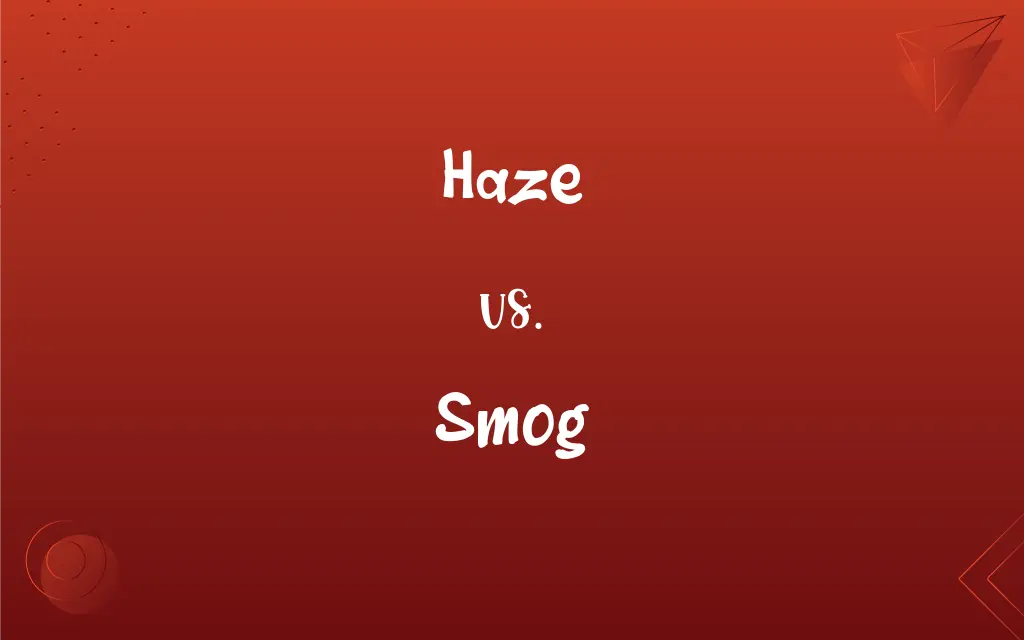Haze vs. Smog: What's the Difference?
Edited by Harlon Moss || By Janet White || Updated on November 30, 2023
Haze is a light atmospheric condition causing slight obscuration of the sky, often due to dust, whereas smog is a type of air pollution combining smoke and fog, often from industrial or vehicular emissions.

Key Differences
Haze is caused by fine particles in the air which scatter sunlight, resulting in reduced visibility. Smog, a blend of smoke and fog, is a more severe form of air pollution, often exacerbated by industrial and vehicle emissions.
The occurrence of haze is typically natural, stemming from dust, pollen, or other particles. In contrast, smog is usually the result of human activities, particularly in urban and industrial areas.
Haze can occur in both rural and urban areas, affecting the clarity of the atmosphere. Smog, however, is more common in densely populated urban centers and is linked to adverse health effects due to its chemical composition.
Haze might simply create a slight obscuration of the landscape, while smog often results in a distinct brown or gray coloration of the sky and significantly reduces air quality.
Haze can sometimes lend a picturesque quality to landscapes, but it does not typically pose significant health risks. Smog, on the other hand, can lead to respiratory problems and other health issues, especially in vulnerable populations.
ADVERTISEMENT
Comparison Chart
Cause
Natural particles like dust and pollen
Pollution from smoke and fog, often man-made
Visibility Impact
Slight obscuration of the sky
Significant reduction in visibility
Health Impact
Generally minimal
Can cause respiratory problems and other health issues
Common Locations
Both rural and urban areas
Primarily urban and industrial areas
Appearance
Light and diffuse
Often brown or gray, denser
ADVERTISEMENT
Haze and Smog Definitions
Haze
Haze is a mild atmospheric phenomenon reducing visibility.
The hikers navigated through the forest despite the haze.
Smog
Smog can be photochemical, formed by reactions between sunlight and pollutants.
The hot, sunny day exacerbated the formation of photochemical smog.
Haze
Haze can be a natural occurrence, often seen during dry, dusty conditions.
The summer haze made the sunset appear even more spectacular.
Smog
Smog is an atmospheric condition caused by vehicle and industrial emissions.
Heavy smog resulted in a health advisory for the metropolitan area.
Haze
Haze refers to a diffuse cloud of fine particles suspended in the atmosphere.
A light haze hung over the city after the dust storm.
Smog
Smog often appears as a dense, dirty fog, particularly in urban areas.
Morning smog blanketed the streets, reducing visibility significantly.
Haze
Haze is a slight obscuration of the lower atmosphere, typically due to fine particles.
The mountains were barely visible through the morning haze.
Smog
Smog is a type of air pollution created by the mixing of smoke and fog.
The city skyline was obscured by a thick layer of smog.
Haze
Haze is a veil of airborne particles creating a softening effect in the air.
Photographers often utilize the natural haze for artistic effect.
Smog
Smog is known for its potential to cause or aggravate respiratory problems.
The increase in smog levels led to a spike in asthma cases in the city.
Haze
Atmospheric moisture, dust, smoke, and vapor that diminishes visibility.
Smog
Fog that has become mixed and polluted with smoke.
Haze
A partially opaque covering
Let the polish dry to a haze before buffing it.
Smog
A form of air pollution produced by the photochemical reaction of sunlight with hydrocarbons and nitrogen oxides that have been released into the atmosphere, especially by automotive emissions.
Smog
A noxious mixture of particulates and gases that is the result of urban air pollution.
Smog
(informal) To get a smog check; to check a vehicle or have it checked for emissions.
If the car is more than five years old, you'll have to have it smogged before you can register it.
Smog
Air pollution by a mixture of smoke and fog
FAQs
What causes haze?
Haze is caused by airborne particles like dust, smoke, and pollen.
Can weather conditions affect smog?
Yes, weather conditions like temperature and sunlight can influence smog formation.
Is smog only found in cities?
While more common in cities, smog can also affect suburban and rural areas near industrial sites.
Is haze a type of pollution?
Haze can be a form of pollution, especially if caused by smoke or industrial particles.
How is smog formed?
Smog forms from pollutants like car emissions and industrial smoke, often in combination with fog.
Is smog harmful to health?
Yes, smog can cause respiratory problems and aggravate existing health conditions.
Can haze affect visibility?
Yes, haze can reduce visibility, but usually not as severely as smog.
Where is haze most common?
Haze occurs in both rural and urban areas, often during dry conditions.
Can haze come from forest fires?
Yes, smoke from forest fires can contribute to haze.
Are there health advisories for haze?
Sometimes, especially when haze is caused by smoke or significant pollution.
Are urban areas more prone to smog?
Yes, smog is more common in urban areas due to higher pollution levels.
Does haze have a natural origin?
Often, yes, as it can be caused by natural factors like dust and pollen.
Can haze affect outdoor activities?
Yes, haze can impact activities like photography or aviation.
Does haze have an impact on climate?
Haze can affect local climates, particularly by influencing temperature and rainfall patterns.
How do authorities measure smog levels?
Smog levels are measured using air quality indexes and pollutant monitors.
Can technology reduce smog?
Yes, technologies like emission controls and renewable energy sources can help reduce smog.
What are the main components of smog?
Smog primarily consists of smoke, fog, and chemical pollutants.
How long can haze last?
Haze duration varies, often lasting from a few hours to several days.
What time of year is smog most prevalent?
Smog is often worse during the summer months in many regions.
Does smog contribute to global warming?
Some components of smog, like greenhouse gases, can contribute to global warming.
About Author
Written by
Janet WhiteJanet White has been an esteemed writer and blogger for Difference Wiki. Holding a Master's degree in Science and Medical Journalism from the prestigious Boston University, she has consistently demonstrated her expertise and passion for her field. When she's not immersed in her work, Janet relishes her time exercising, delving into a good book, and cherishing moments with friends and family.
Edited by
Harlon MossHarlon is a seasoned quality moderator and accomplished content writer for Difference Wiki. An alumnus of the prestigious University of California, he earned his degree in Computer Science. Leveraging his academic background, Harlon brings a meticulous and informed perspective to his work, ensuring content accuracy and excellence.































































